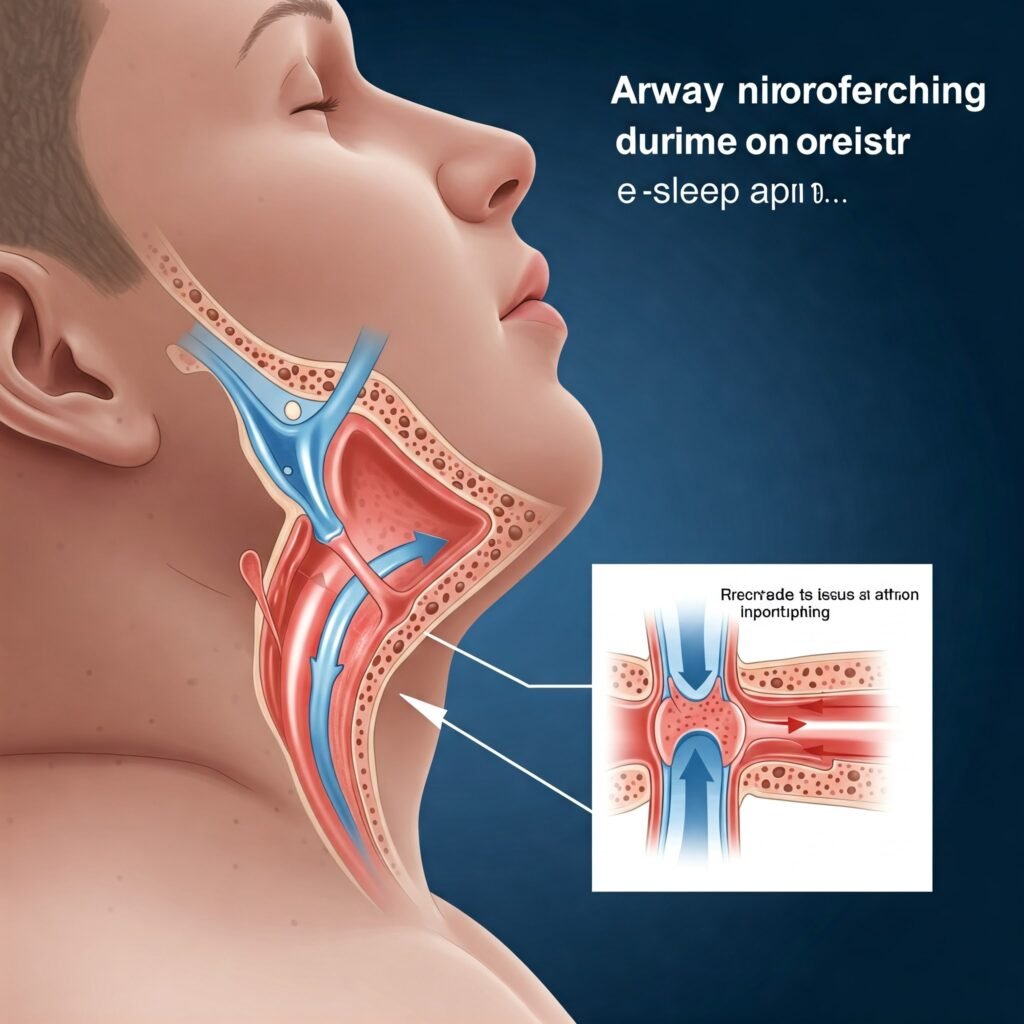Understanding Sleep Apnea is crucial because it’s more than just disruptive sleep – it can have significant impacts on your overall health and quality of life. This post will break down what sleep apnea is, dive into its common causes, help you recognize the key symptoms, and explore the various effective treatment options available. Let’s get started on understanding this important condition.
What Exactly is Sleep Apnea?
At its core, sleep apnea is a condition characterized by repeated interruptions in breathing during sleep. These pauses, called apneas, or periods of shallow breathing, called hypopneas, can last from a few seconds to minutes and may occur 5 to 30 times or more per hour. When your breathing stops or becomes shallow, your brain briefly rouses you from sleep so that you can resume breathing. However, these awakenings are usually so brief that you don’t remember them.
There are different types of sleep apnea, but the most common is Obstructive Sleep Apnea (OSA). This happens when the airway collapses or becomes blocked during sleep, usually because the soft tissues in the back of the throat relax too much. Less common types include Central Sleep Apnea (CSA), where the brain doesn’t send proper signals to the muscles that control breathing, and Mixed Sleep Apnea, a combination of both. This article primarily focuses on understanding sleep apnea, particularly the more prevalent OSA.
Understanding the Causes of Sleep Apnea
So, why do these breathing interruptions happen? While the exact mechanism varies slightly depending on the type, understanding the causes of sleep apnea, especially OSA, often boils down to factors that affect the structure and function of your airway during sleep.
Several risk factors increase your likelihood of developing obstructive sleep apnea:
Risk Factors for Sleep Apnea
- Excess Weight/Obesity: This is one of the most significant factors. Fat deposits around the upper airway can narrow the passage, making it more likely to collapse during sleep.
- Neck Circumference: A thicker neck (greater than 17 inches in men, 16 inches in women) indicates a narrower airway.
- Male Gender: Men are two to three times more likely to have sleep apnea than women. However, the risk increases for women after menopause.
- Older Age: Sleep apnea occurs significantly more often in older adults.
- Genetics & Airway Anatomy: Naturally narrow airways, a receding jaw, or a large tongue can predispose you to sleep apnea. Family history also plays a role, suggesting a genetic component.
- Nasal Congestion: Chronic nasal congestion, due to allergies or other causes, can make breathing more difficult and increase the risk.
- Smoking: Smoking increases inflammation and fluid retention in the upper airway.
- Alcohol and Sedatives: These substances relax the muscles in the throat, exacerbating airway collapse.
- Certain Medical Conditions: Conditions like heart disorders, stroke, hypothyroidism, and Polycystic Ovary Syndrome (PCOS) are associated with an increased risk of sleep apnea.

Recognizing the Symptoms of Sleep Apnea
The signs of sleep apnea can sometimes be subtle or attributed to simple tiredness, but recognizing the symptoms of sleep apnea is crucial for seeking diagnosis and treatment. Many symptoms occur during sleep, meaning a bed partner is often the first to notice them.
Common Signs of Sleep Apnea
Here are some of the most common symptoms:
- Loud and frequent snoring: This is often the most noticeable symptom, though not everyone who snores has sleep apnea.
- Observed episodes of breathing cessation during sleep: A bed partner might notice pauses in breathing followed by gasping or choking sounds.
- Abrupt awakenings accompanied by gasping or choking: These moments are often scary for the individual or their partner.
- Excessive daytime sleepiness (hypersomnia): Feeling very tired during the day, even after a full night’s sleep. You might fall asleep at work, while driving, or watching TV.
- Morning headache: Waking up with a dry mouth or sore throat.
- Difficulty concentrating, memory problems, and irritability: Lack of restorative sleep affects cognitive function and mood.
- High blood pressure: Sleep apnea is closely linked to hypertension.
- Decreased libido.
If you or someone you know is experiencing several of these symptoms, especially loud snoring combined with daytime fatigue, it’s important to consider the possibility of sleep apnea.
Why is Treating Sleep Apnea Important?
Beyond just making you tired, treating sleep apnea is vital because untreated, it can lead to a host of serious health problems.
The Impact of Untreated Sleep Apnea
Repeated drops in blood oxygen levels and fragmented sleep put significant stress on your body. This chronic stress increases the risk of:
- High blood pressure
- Heart attack and stroke
- Type 2 diabetes
- Metabolic syndrome
- Liver problems
- Complications with medications and surgery 1 1. blog.apriadirect.com blog.apriadirect.com
Addressing sleep apnea can significantly reduce the risk of these conditions and dramatically improve your quality of life, energy levels, and overall well-being.
Exploring Treatment Options for Sleep Apnea
The good news is that sleep apnea is a treatable condition. Exploring treatment options for sleep apnea should always start with a proper diagnosis from a healthcare professional, usually involving a sleep study. Based on the severity and type of apnea, your doctor will recommend the most suitable approach.
Effective Treatments for Sleep Apnea
Here are some common and effective treatment options:
- Continuous Positive Airway Pressure (CPAP): This is the most common and highly effective treatment for moderate to severe OSA. A machine delivers air pressure through a mask worn over the nose or nose and mouth while you sleep. This pressure keeps your airway open, preventing pauses in breathing. While it takes some getting used to, many people find CPAP life-changing.
- Oral Appliances: For mild to moderate OSA, a dentist specializing in oral appliances can fit you with a custom-made mouthpiece. These devices typically reposition the jaw forward or hold the tongue in place to keep the airway open.
- Lifestyle Changes:
- Weight Loss: Even a modest weight loss can significantly improve or even eliminate symptoms for some individuals.
- Positional Therapy: Sleeping on your side rather than your back can help keep the airway open. Special pillows or devices can help you maintain a side-sleeping position.
- Avoiding Alcohol and Sedatives: Especially in the hours before bedtime, as these relax throat muscles.
- Quitting Smoking: Improves overall respiratory health.
- Surgery: Various surgical procedures can enlarge the airway or remove obstructions (like tonsils or adenoids, if enlarged). Surgery is typically considered when other treatments haven’t been successful or in specific anatomical situations.
The right treatment plan is personalized. Working closely with your doctor and sleep specialist is key to finding the best approach for you.
How is Sleep Apnea Diagnosed?
If sleep apnea is suspected, the next step is typically a sleep study. This is often a Polysomnography (PSG), which can be done in a sleep lab or sometimes at home. The study monitors your breathing patterns, oxygen levels, heart rate, brain waves, and muscle activity while you sleep to accurately diagnose the presence and severity of sleep apnea. [Link to Sleep Foundation/Mayo Clinic on Sleep Study]
Living with Sleep Apnea
Once diagnosed and treated, living with sleep apnea becomes much more manageable. Adhering to your prescribed treatment, maintaining healthy lifestyle habits, and attending follow-up appointments are crucial for long-term success and improved health.
Conclusion
Understanding Sleep Apnea is the first step towards better health and more restful nights. By recognizing the causes and symptoms, and exploring the available treatment options, you can take proactive steps to address this condition. If you suspect you or a loved one might have sleep apnea, don’t delay seeking medical advice. A diagnosis and appropriate treatment can not only improve your sleep but also significantly reduce your risk of serious health complications. Take control of your sleep health today!
































